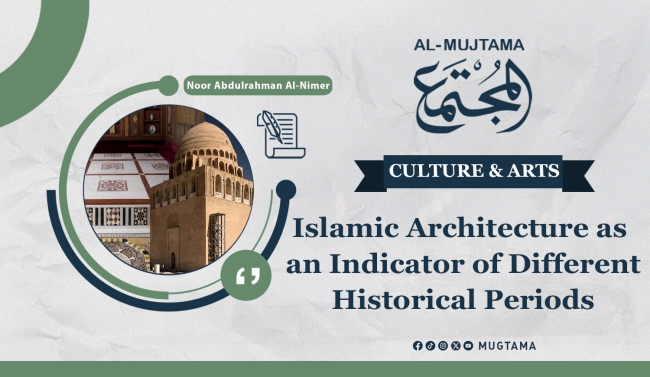Islamic Architecture as an Indicator of Different Historical Periods Featured
Islamic architecture is one of the most prominent historical testimonies of various eras, reflecting the succession of rulers and the cultural and artistic heritage they left behind. This heritage transcends mere construction and function to form an artistic and civilizational language that mirrors the cultural, social, and political character of each era and place.
From Damascus to Cairo, Morocco, and Andalusia, the mutual influence between geography, local cultures, and Islamic heritage is evident in architectural designs.
Damascus: The Umayyad Mosque
The Umayyad Mosque is considered the crown jewel of Islamic architecture. Yaqut al-Hamawi described its exquisite craftsmanship, noting that one could spend a hundred years admiring it each day and still discover something new.
When Caliph Al-Walid ibn Abd al-Malik commissioned the construction of the Umayyad Mosque, his vision went beyond creating a place for prayer; he aimed to build a monument symbolizing his state and eternalizing its legacy through this structure.
This vision is reflected not only in its architecture but also in its inspiration from other influences. Initially, mosaic art was exclusive to Byzantine churches, but it was used in the Umayyad Mosque to showcase the character of Muslims and their knowledge of their religion and afterlife.
Contrary to Byzantine use, the mosque's mosaics do not depict living beings. Instead, they feature creative representations of trees bathed in sunlight, suggesting the eternal bliss awaiting believers, as though the mosque's walls, adorned with these motifs, embody the intermediary state between believers and their promised divine rewards.
The Umayyad Mosque influenced subsequent Islamic architecture, becoming a model for grand mosque designs. Historian Henri Terrasse, in his book *Art and Architecture in Islam*, stated that the Umayyad Mosque laid the foundations for Islamic architecture by blending function and symbolism.
This blend of function and symbolism should not be overlooked, as contemporary architecture often prioritizes function over symbolism. The term "function" refers to the intended purpose of a building, whether for prayer or residency, while "symbolism" encompasses both aesthetic value and geographical context for those entering or passing by the structure.
In today's urban landscape, we often see only concrete or glass facades, a testament to the brutalist architecture movement, an offshoot of modern architecture, which favors functionalist designs.
Cairo: The City of a Thousand Minarets
Cairo is a unique city, as its architectural identities are as diverse as its numerous minarets. Dr. Nizar Al-Sayyad highlighted Cairo's rich architectural heritage in his book *Cairo and Its Architecture: Histories, Rulers, and Places*.
Dr. Al-Sayyad mentions the Ibn Tulun Mosque, which exhibits influences from the architectural techniques of Caliph Al-Mu'tasim's court, such as the use of gypsum decorations and limestone in the construction of its minaret, elements previously uncommon in Cairo.
Pointed Arches and Intricate Decorations
The famous Al-Azhar Mosque, with its pointed arches and intricate decorations introduced by the Fatimids, is another notable example. Robert Hillenbrand, in his book *Islamic Architecture: Form, Function, and Meaning*, explains that Fatimid decorations were more than mere embellishments; they expressed the spiritual and political power of the Fatimid state.
Significant Fatimid Innovation
Historian Doris Behr, in “Cairo's Islamic Architecture”, describes Al-Azhar Mosque as a significant Fatimid innovation showcasing advanced architectural understanding, blending aesthetic and spiritual dimensions, akin to the Umayyad Mosque's fusion of function and symbolism.
In the Mamluk era, architecture was characterized by grandeur and intricate decorations, as seen in the Sultan Hassan Mosque and Madrasa, where precious stones were used to create decorative domes and minarets.
Morocco: The Mosque and the University
In Morocco, the Al-Qarawiyyin Mosque in Fez, established in the 9th century, is the oldest university in the world and the first founded by a woman, Fatima al-Fihri. It is said she fasted throughout the construction of the mosque, expressing gratitude to God and hoping for the completion of the project, which it was, may her soul rest in peace.
The mosque's design represents a blend of function and symbolism, with sundials indicating prayer times and fountains for ablutions.
Andalusia: The Pinnacle of Creativity
The Alhambra Palace in Granada is one of the greatest achievements in Islamic architecture, a witness to the golden age of Islamic civilization. Built in the 13th century by the Nasrid rulers, its central courtyard, the Court of the Lions, represents a pinnacle of engineering innovation with its fountain distributing water through small channels to all parts of the courtyard, reflecting the ingenious water system of the Alhambra.
Comprehensive Artistic Vision
Edward Said, in *Orientalism*, noted that Andalusian architecture embodies a comprehensive artistic vision, where buildings transcend mere function to become embodiments of the spirit of place and time.
Islamic architecture is not only an art of construction but also a reflection of the cultural diversity and artistic richness of Islamic civilization across different eras and regions, as seen in Damascus, Cairo, Morocco, and Andalusia. Each period leaves a unique imprint, providing practical applications of religious principles, such as the Umayyad Mosque's decorations and the Al-Qarawiyyin Mosque's sundials. Throughout history, Islamic architecture has maintained the balance between practical functionality and symbolic significance, leaving a lasting impact that continues to inspire contemporary builders and designers.
Studying Islamic architecture offers a deeper understanding of the cultural and artistic achievements of Islamic civilization and its role in shaping a unique human identity.
--------
Read the article in Arabic


